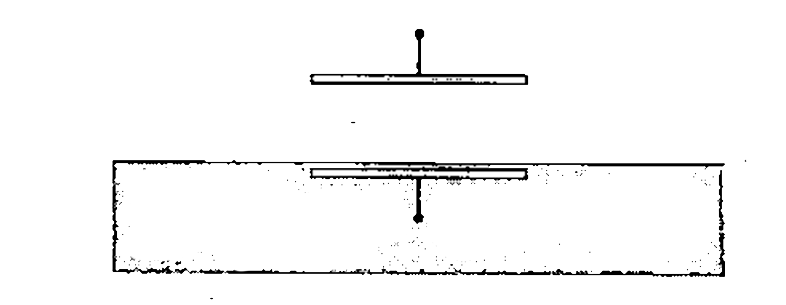A parallel-plate capacitor that has been first charged and then disconnected from the voltage source is submerged in the vertical position into a liquid dielectric. How does the level of the dielectric. between the plates change in the process?
Step by step video & image solution for A parallel-plate capacitor that has been first charged and then disconnected from the voltage source is submerged in the vertical position into a liquid dielectric. How does the level of the dielectric. between the plates change in the process? by Physics experts to help you in doubts & scoring excellent marks in Class 12 exams.
Topper's Solved these Questions
Similar Questions
A parallel-plate capacitor with vertical plates is connected to a voltage source and then submerged into a liquid dielectric. How does the level of the dielectric between the plates change in the process? Explain the change of the energy stored by the capacitor
View SolutionThe dielectric filling the space between the plates of a capacitor that has been charged and then disconnected from the voltage source is removed. How should the distance between the plates be changed so that the energy stored in the capacitor remains the same? Explain the origin of the change in energy.
View Solution
Knowledge Check
- Question 1 - Select One or More
A parallel-plate capacitor is charged from a cell and then disconnected from the cell. The separation between the plates is now double.
AThe potential difference between the plates will become doubleBThe field between the plates will not change.CThe energy of the capacitor doubles.DSome work will have to be done by an external agent on the plates. - Question 2 - Select One
A parallel plate air condenser is charged and then disconnected from the charging battery. Now the space between the plates is filled with a dielectric then, it electric field strength between the plates
Aincreases while its capacity increasesBincreases while its capacity decreasesCdecreases while its capacity increasesDdecreases while its capacity decreases - Question 3 - Select One
Assertion: A parallel plate capacitor is charged to a potential difference 100V, and disconnected from the voltage source. A slab of dielectric is then slowly inserted between the plates. Compared to the energy before the slab was inserted, the energy stored in the capacitor with the dielectric is decreased.
Reason: When we insert a dielectric the plates of a capacitor, the induced tend to draw in the dielectric into the field (just as neutral). we resist this force while slowly inserting the dielectric, and thus do negative work on the system, removing electrostatic energy from the system.AIf both assertion and reason are true and reson is the correct explanation of assertion.BIf both assertion and reason are true but reason is not the correct explanation of assertion.CIf assertion is true but reason is false.DIf assertion and reason both are false.
Figure shows a horizontal parallel plate capacitor is lowered on a liquid surface in such a way that its lower plate is just submerged in the liquid of dielectric constant k. Find the height to which the liquid level will be raised between the plates if the capacitor plates are given a surface charge density +σ and−σ on its plates.
 View Solution
View SolutionA parallel plate capacitor is charged to a certain potential difference and the battery used to charged it is disconnected. Now a dielectric slab of dimensions equal to spacing between plates is introduced between the plates. What will be the changes, if any, in the charge, potential difference, capacitance, electric field strength and the energy stored in the capacitor?
View SolutionA parallel plate capacitor is first connected to a constant voltage source. It is then disconnected and ·then immersed in a liqnid dielectric, then:
View SolutionA parallel plate copacitor is first charged and then isolated, and a dielelctric slab is introduced between the plates. The quantity that remains unchanged is.
View SolutionA parallel capacitor of capacitance C is charged and disconnected from the battery. The energy stored in it is E. If a dielectric slab of dielectric constant 6 is inserted between the plates of the capacitor then energy and capacitance will become.
View Solution

